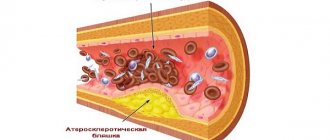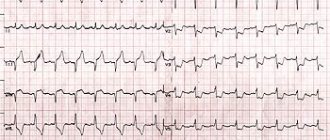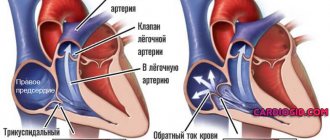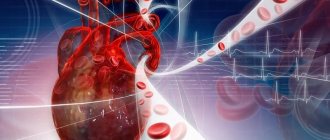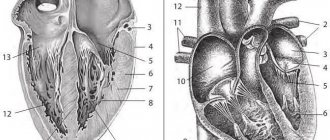Risks of using an IR device
Vascular bypass with open access and cardiac arrest is associated with the risk of developing the following complications:
- possibility of bleeding;
- necrosis of a portion of the heart muscle;
- incomplete fusion of the thoracic incision;
- renal failure;
- venous thromboembolism;
- cerebral artery stroke;
- amnesia (memory loss);
- large scars on the chest;
- pronounced pain symptom.
After the operation, until the postoperative wound has completely healed, you should not take a bath, use gels, or rub in the suture area. You should not take a hot shower or use lotions.
Open heart surgery
And although this approach has become more popular with the development of minimally invasive cardiovascular surgery, in most cases open traditional surgery is still used. It is recommended when treatment involves complex reconstruction of the coronary vessels, valves, cavities and other parts of the heart in one operation.
The procedure is performed under general anesthesia and lasts about 5-6 hours. First, the surgeon makes a long incision (15-20 cm) in the patient's chest to gain access to the heart. After this, a cardiopulmonary resuscitation machine is connected, which supplies the body with oxygen and nutrients, and the heart temporarily stops.
Treatment of heart defects in children in leading clinics in Europe
The Sant Joan de Déu Clinic is a specialized clinic in Spain, its main focus is the treatment of rare and serious diseases of children and adolescents. Cardiology is one of the main areas of the clinic. Here they diagnose and treat newborns, children and adolescents with congenital structural heart defects, rhythm and electrical conductivity disorders of the heart, congenital and acquired heart diseases. The work of doctors is aimed at providing medical care to young patients at the highest level, according to the standards of the best clinics in the world. Sao Joao de Déu has one of the lowest operative mortality rates in Europe and a very low re-intervention rate. Modern technologies and techniques are used here to treat children with heart defects.
Complex congenital pathologies are one of the main specializations of the University Hospital of Munich. An integrated approach to diagnostics allows us to identify even the most subtle abnormalities in the heart and determine the extent of damage to the cardiac system. The clinic uses the latest methods for treating heart defects in children, including the Da Vinchi robot. In addition, the university is constantly conducting research and development in the field of pediatric cardiology, so the clinic is constantly updating and improving treatment options.
2.Stages of operation
At the first stage
the patient is connected to cardiac monitors, the chest is processed, breathing tubes are inserted from an artificial respiration apparatus, which is connected only after the anesthesia begins to take effect (i.e., the only discomfort for the patient may be some soreness and soreness in the throat after the operation).
The anesthesiologist puts the patient under general anesthesia. From this moment on, the patient does not feel anything.
An ultrasound device is placed through the esophagus into the heart area, transmitting an image of the heart to a monitor throughout the operation.
Second phase
- This is the opening of the chest. After marking, the heart surgeon makes an incision on the chest from the top of the rib cage to the navel. With the minimally invasive method, the incision length is two-thirds shorter.
The purpose of the third stage
is connection to a machine that provides artificial blood circulation. During the operation, the blood is enriched with oxygen outside the lungs, then it returns to the aorta and moves through the systemic circulation.
At this stage, the surgeon stops the heart, washes it and places it in a special solution that maintains its viability outside the circulation.
Fourth and fifth stages
- This is actually replacing the valve. The aorta is cut and the diseased valve is removed. If part of the aorta is also affected, it is also removed and a graft is placed. The valve hole is measured to select a new valve of the required size. The new valve is sewn on, then it is necessary to check that there are no leaks through it.
Sixth stage
- this is a disconnection from the artificial blood circulation machine. The aorta is sutured, and the trapped air is removed from the heart cavity. The heart begins to beat under the current of its own blood. If an uneven rhythm is observed, an electric shock is applied, which restores an even pulse.
Seventh stage
- chest closure. The bones and tissues are stitched together, and the sternum is closed with a suture that remains visible for life.
The entire operation usually lasts from 2 to 5 hours.
is important for the outcome of treatment .
It starts in the intensive care ward. Discharge from the hospital occurs 5-9 days after surgery. Postoperative rehabilitation continues on an outpatient basis.
Visit our Cardiology page
Consequences and rehabilitation in the postoperative period
After the operation, the patient is in the intensive care unit. Doctors monitor the patient’s condition, as negative consequences are possible and he will need rehabilitation . On the first day, there may be complications such as internal bleeding, thromboembolism, cardiac arrhythmias, infective endocarditis, and heart attack (in less than 5% of cases). After two days, the patient is allowed to get up and walk. At this time, he may complain of chest pain and increased fatigue. The patient is discharged home within 4 to 10 days, where he is under the supervision of a doctor.
The postoperative period lasts 3 weeks, during which temporary disturbances in sleep, vision, appetite, and swelling of the legs are possible. A month later the patient undergoes a full examination. The cardiologist calculates adequate physical activity, diet, and prescribes supportive treatment. It is important to perform physical therapy to strengthen the heart muscle.
Cardiac surgeries with cardiopulmonary bypass (CPB)
Access with the traditional method is performed along the midline of the sternum. The heart is turned off from the blood circulation. Life functions are supported using an infrared apparatus, which is connected to the aorta and vena cava. The blood is saturated with oxygen and enters the body. The gas exchange process occurs in the IR apparatus itself, where the blood also maintains the required temperature and is filtered.
Coronary artery bypass surgery is performed on a non-functioning heart. The surgeon makes an anastomosis between a healthy area of the coronary vessels and a vein. The minimum time to complete the operation is three to five hours. The heart is included in the blood circulation after completion of surgery on all affected vessels.
Coronary artery bypass surgery has varying degrees of complexity. This depends on the number of arteries affected and the general condition of the patient. Therefore, the duration of the procedure is determined individually. The more anastomoses that need to be implanted, the longer the procedure takes.
Indications for surgical treatment of coronary vessels
Coronary artery bypass surgery - the formation of bypass blood flow in stenotic vessels - is performed according to specific indications:
- narrowing of the left coronary artery by more than 50%;
- resistance to therapeutic methods for treating angina pectoris;
- violation of myocardial contraction;
- extensive area of ischemia;
- atherosclerotic damage to several vessels;
- arterial damage in patients with concomitant pathologies;
- narrowing of coronary vessels more than 70%.
Types of heart valve replacement surgeries
Surgeons perform 2 types of operations. Valve insufficiency is corrected using plastic surgery. When the valve narrows (stenosis), it is completely replaced. The most common surgery is to replace the heart's mitral or aortic valve.
Two types of prostheses are used - biological and mechanical. Biological, porcine valve, is installed in elderly patients. It does not provoke blood clots and lasts 8-15 years. The disadvantage of a porcine prosthesis is the high risk of bacterial inflammation. The mechanical valve has a service life of more than 20 years, but with it the person must take blood thinners for life.
A heart valve is replaced when it wears out. The cost of the operation is determined by the surgeon based on a complete examination of the patient.
Examples of prices for cardiac bypass surgery
For a foreigner who needs to undergo surgery with plastic surgery of 3 valves in Moscow from one of the best specialists, it will cost about a million rubles, excluding rehabilitation costs. For a healthcare worker in Russia, the same procedure will cost about 700,000 , also excluding rehabilitation. Coronary artery bypass surgery on a living beating heart (without artificial blood flow) for Russian citizens will cost about 200,000 rubles , for foreigners approximately 350,000 .
What determines the cost of coronary bypass surgery?
The operation, although relatively common, is far from simple. There are a huge number of factors that influence the invoice that will be issued.
- Technology - if a mini-access is used, then the cost of the operation itself increases significantly, but the rehabilitation period will be much shorter, because in this technology there is no dissection of the chest.
- Difficulty - before any surgical intervention, and indeed before making a diagnosis, it is customary to conduct an examination to understand how advanced everything is, how potentially complex the operation will be, whether there are great risks, whether there is a need for such a serious intervention at all. And the worse the situation, the more expensive the operation will cost.
- The patient’s status is in Russia; if the patient is a foreigner, then in most cases coronary bypass surgery will cost him one and a half times more. Discounts are usually provided for healthcare employees.
- Qualification of the surgeon - the higher the category of the operating doctor, the more expensive his services will cost.
If you suddenly need such a procedure, you need to be prepared to pay twice or three times the originally stated price.



